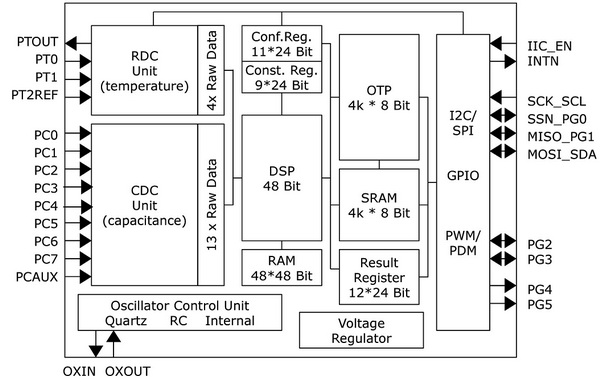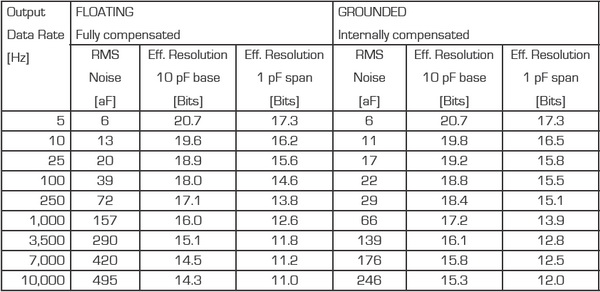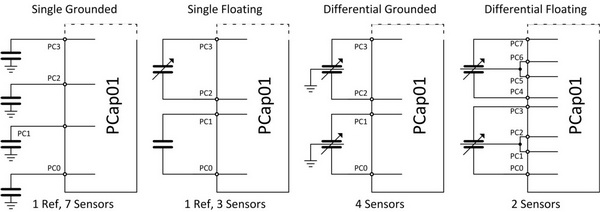1 Introduction
This article refers to the address: http://
Capacitive sensors are widely used in many industrial and consumer products, and are popular in many fields due to their small size, low power consumption, and high precision. For the measurement of capacitive sensors, the traditional circuit method has its limitations that cannot be overcome. Complex analog circuit design, difficult to expand capacitance measurement range, will bring great resistance to development. Although there are some so-called easy-to-use single-chip solutions for capacitance-to-digital converters, there are still many limitations in terms of price, performance, and simplicity.
The patented PICOCAP® measurement principle from acam Germany provides a revolutionary breakthrough in capacitance measurement. In 2011, the latest PCAP01, a single-chip capacitive measurement solution with an internal DSP microcontroller, was introduced, which increases capacitance measurement to an unprecedented level.
2. Overview
PCap01 is a single-chip solution for capacitance digital conversion with capacitance measurement. The chip's measurement range covers from a few fF to a few hundred nF, and can be configured to meet the needs of a variety of different applications. PCap01 is suitable for ultra-low power consumption down to a few uA measurements, high-performance measurements with high-precision 21-bit effective bits, and fast measurements up to 500,000 times per second. This chip provides the perfect combination for high precision measurements, low power measurements and fast measurement applications. Sensor data can be calibrated internally within the chip and then transmitted via the SPI or IIC data serial interface. In addition, the chip can also send PWM / PDM output voltage signals through the IO port. The remaining IO ports can be used as interrupt pins, horizontal alarm signal pins or normal IO ports.
The PCap01 has a very small QFN package size and requires only a small number of external components (at least 2 external two-pass capacitors are required), making the entire system very compact and cost-effective for a wide range of capacitance measurements.
3. Introduction to PICOCAP measurement principle

The PICOCAP measurement principle demonstrates a new revolutionary approach to capacitance measurement. In this principle, the capacitance of a sensor and a reference capacitor are connected to the same discharge resistor to form a Low-pass low-pass filter.
The capacitor is first charged to the supply voltage and then discharged through the resistor. The level discharged to a controllable threshold voltage will be recorded by the very high precision time-to-digital converter TDC inside the chip.
This measurement process will be repeated over the sensor and reference capacitors, applying the same resistance. The result of the calculation is the measured ratio result, which is related to the resistance and comparator temperature dependence. The choice of sensor and reference capacitor values ​​should be uniform to reduce the gain offset. From a practical point of view, there is no size limit for the capacitor to be measured. Sensors can range from 0fF to tens of nf. PICOCAP also supports the measurement of differential capacitive sensors with internal linear compensation.
4. PCAP01 chip main features
The Pcap01 chip is a single-chip capacitor measurement solution with some features:
n
One chip can be used for a variety of applications, and measurement flexibility is very high:
a)
Low measurement power consumption, at a minimum of 2 μA at 10 Hz
b)
Measurement accuracy up to 22 significant digits, 4 aF rms accuracy
c)
Measurement frequency up to 500 kHz
n
Very wide capacitance measurement range, from a few fF to hundreds of nF
n
Ultra low gain and offset drift
n
18-bit high resolution temperature measurement
n
48-bit DSP, 4k byte OTP, 4k byte SRAM
n
Internal or external clock oscillation
n
Supports up to 6 IO ports
n
IIC, SPI, PWM, PDM interface
n
Wide supply voltage range from 2.1 V to 3.6 V
n
Wide operating temperature range (-40 ° C to +125 ° C)
n
QFN32 or QFN24 package
Internal structure schematic:

Pcap01 takes advantage of the high precision of the PICOCAP® measurement principle, making capacitance measurement an unprecedented level. Depending on the size of the sensor and reference capacitor, and the selected measurement mode, we have the following measurement data. This measurement is typical measurement noise accuracy vs. data output frequency. Our test is done using the Pcap01 evaluation system with a 10pF reference capacitor and a 1pf Span load capacitor. The voltage of the chip is V = 3.0 V:

In the above table,
See, we give the floating drift mode and the Grounded ground mode. When applying the drift mode, fully compensated, the RMS noise measured at 5 Hz output is 6 aF, and the measured effective bit is up to 20.7 bits! In the case of selecting different settings for different measurement frequencies, the relative relationship between accuracy and speed is given in the table. Out.
Of course, depending on the size of the base capacitor, the effective resolution of the measurement will vary.
When applying the compensation mode for high-precision measurement, the measurement can have very low gain and zero drift. Capacitors can be connected to ground, drift mode. The sensor and reference capacitor are selected into the discharge network by an integrated analog switch. In addition, due to the patented circuit and compensation algorithm, the internal parasitic capacitance can be compensated. The result of the compensation can achieve a gain offset of only 0.5 ppm /K over the temperature range. This is much better than the internal offset of most sensors themselves.
How the sensor is connected:
For capacitive sensor measurements, the chip provides a very flexible connection, compared to the typical connection method as follows:

In the chip, the user can choose whether to use the internal integrated discharge resistor for capacitance measurement or an external discharge resistor for measurement. The connection is as follows:

Wire compensation:
In capacitance measurement, the influence of the parasitic capacitance of the wire on the entire measurement cannot be ignored. Especially in the case of long wires, the influence of the parasitic capacitance of the wires will have a fatal effect on the measurement results. In Pcap01, the sensor's wire parasitic capacitance can be effectively compensated:
20 KV Oil Immersed Transformer
20 Kv Oil Immersed Transformer,Power-Saving Oil-Immersed Transformer,High Efficiency Oil-Immersed Transformer,Dust-Proof Oil-Immersed Transformer
Tianhong Electric Power Technology Co., Ltd , https://www.tianhongtransformer.com
![<?echo $_SERVER['SERVER_NAME'];?>](/template/twentyseventeen/skin/images/header.jpg)